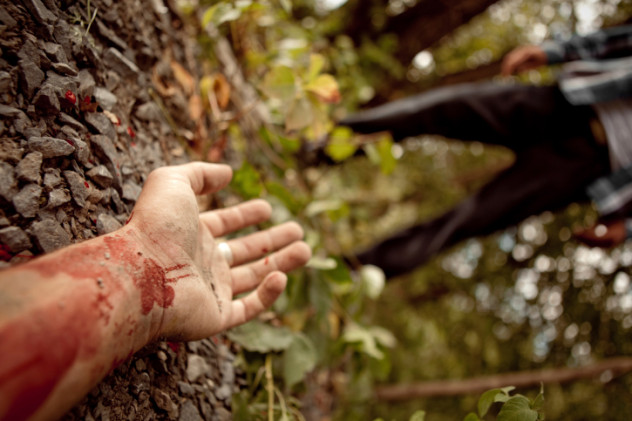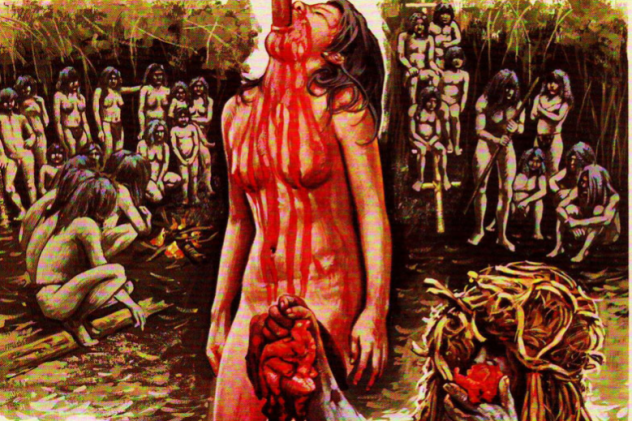 Mysteries
Mysteries  Mysteries
Mysteries  History
History 10 Surprising Stories About the Texas Rangers
 Humans
Humans 10 Philosophers Who Were Driven Mad by Their Own Theories
 Miscellaneous
Miscellaneous 10 Video-Game-Worthy Weapons and Armors from History
 Weird Stuff
Weird Stuff 10 Psychics Who Accurately Predicted Wartime Events
 The Arts
The Arts 10 Pieces of Art Inspired by a Broken Heart
 Health
Health 10 Science Fiction-Sounding New Medical Treatments
 History
History 10 Surprising Facts About the Father of Submarine Warfare
 Space
Space Ten Astonishing New Insights into Alien Worlds
 Weird Stuff
Weird Stuff 10 Bizarre Summer Solstice Rituals Still Practiced Today
 Mysteries
Mysteries Top 10 Haunting Facts About the Ghost Ship MV Alta
 History
History 10 Surprising Stories About the Texas Rangers
 Humans
Humans 10 Philosophers Who Were Driven Mad by Their Own Theories
Who's Behind Listverse?

Jamie Frater
Head Editor
Jamie founded Listverse due to an insatiable desire to share fascinating, obscure, and bizarre facts. He has been a guest speaker on numerous national radio and television stations and is a five time published author.
More About Us Miscellaneous
Miscellaneous 10 Video-Game-Worthy Weapons and Armors from History
 Weird Stuff
Weird Stuff 10 Psychics Who Accurately Predicted Wartime Events
 The Arts
The Arts 10 Pieces of Art Inspired by a Broken Heart
 Health
Health 10 Science Fiction-Sounding New Medical Treatments
 History
History 10 Surprising Facts About the Father of Submarine Warfare
 Space
Space Ten Astonishing New Insights into Alien Worlds
 Weird Stuff
Weird Stuff 10 Bizarre Summer Solstice Rituals Still Practiced Today
10 Movies Plagued By Ethics Violations
Press can make or break a movie. Sometimes, it’s bad press that makes something a success, enticing people to the theaters just to see what all the fuss is about. Other times, bad press can sink a movie before it’s ever released. In some cases, it can sink the entire company responsible for it. We expect a certain amount of ethical responsibility when directors and actors are making a movie—unfortunately, it doesn’t always happen that way.
10 Snuff

Snuff films have long been the stuff of urban legends—we’ve even talked about them a few times, here and here. For a quick recap, snuff films don’t rely on special effects and fake gore. They’re supposed to be the real thing. The defining characteristic of the snuff film is that it’s not an accidental death, it’s a planned death for the sake of entertainment. It’s been proven time and time again that there’s no such thing commercially available (yet). One film in particular was not only plagued with accusations that it was a real snuff film, but those behind the scenes encouraged it.
In 1971, a few almost-amateur filmmakers released a subpar gore-fest in Argentina. It was called Slaughter, and it was ultimately bought by another company that specialized in sexploitation films—movies that weren’t porn, but just barely. When the first American audiences got a look at it, the rumor started that it wasn’t just a movie—it was real. By December 1, 1975, the movie had been re-titled Snuff and re-released amid a major controversy that surrounded a marketing campaign that very, very carefully didn’t confirm or deny any behind-the-scenes rumors. The original filmmakers were paid to disappear. Slowly, the marketing team behind the movie began to issue false news stories about a fictional organization and crusader who was working to get the movie shut down because of its depiction of real violence.
The result was national hysteria, hysteria that led to the movie’s trip straight to the top of the box office when it was finally released in January of 1976 with an ending that wasn’t part of the original film. The final scene—the product of a one-day shoot—was the apparent murder and dismembering of the lead actress. It ends only when the cameraman comes to the end of his film reel, and even though the Los Angeles Police Department said that there was no evidence whatsoever that the film was real, accusations and myths have persisted.
9 Birth Control

Born in 1879, Margaret Sanger was a champion for what’s still one of the most controversial of all the hot-button topics: birth control. After seeing her mother suffer with and ultimately die from the physical strain of 11 children and seven miscarriages, Sanger went to nursing school and took up the cause of getting birth control into the hands of the masses. She made a movie and established clinics and mail order services.
Birth Control, filmed in 1917, attracted the moral and ethical outrage of people from the church and the political realm. The film, which was a factual telling of Sanger’s nursing career and the consequences she had seen of women forced to bear child after child or suffering through botched abortions, got such an outcry from the public that the New York State Commissioner of Licenses threatened to revoke the theater license of any establishment that showed the movie. Physicians were angry because the idea that a woman would want sex without children was unnatural, while churches and other groups pointed to Sanger’s lack of morality and the idea that birth control would lead to wanton, lustful encounters and immoral behavior.
The ethical dilemma went so far as accusations of attempts to cause class warfare. Sanger presented the wealthy upper class with their small families as a stark contrast to the poor family struggling with the burden of too many children and the ill health that came with them. The public outcry couldn’t stop the momentum that was already building, though, and Sanger went on to form the American Birth Control League (which would later give rise to Planned Parenthood) and to continue to champion her cause until her death in 1966.
8 Hounddog

In 2007, 12-year-old Dakota Fanning appeared in the film Hounddog. The movie, about a Southern pre-teen growing up with an abusive father and Bible-banging grandmother, took 12 years to make it to the screen. When it did, it was targeted for child abuse. The hate was mostly because of one scene: the shadowy, indistinct, and not-seen-on-camera rape of Fanning’s character.
What the director saw as social commentary, critics panned and movie theaters refused to show. When it premiered at the Sundance Film Festival, it was largely unfinished with rough edits and little in the way of background noise. The other problem was the appearance of the underage actress, even though Dakota Fanning herself spoke out in favor of the movie. Her response to critics—including representatives of Catholic activist groups—was that not only was her mother on set all day along with her agent and her teachers, but also that it’s not real. She was also quick to point out that it’s acting, that it’s not really happening to any of the people involved, but it’s their characters going through something horrible—something which, director Deborah Kampmeier says, happens to kids in real life all the time. Fanning herself agreed, saying that for her, it was the chance to educate viewers about things that happen but no one wants to talk about. But none of that stopped organizations like the Christian Film and Television Commission and the Catholic League for Religious and Civil Rights from going to the US Department of Justice and inquiring whether or not there had been any violations of child pornography laws.
While the Motion Picture Association of America declined to give the film a rating, its director has gone to other groups like the New York City Alliance Against Sexual Assault for help in getting the movie to theaters. That finally happened a year after its Sundance debut, and it wasn’t without more protest.
7 Cannibal Holocaust

We’ve mentioned Cannibal Holocaust a few times before (most notably here) when we talked about the controversy surrounding the making of the films, the animal cruelty and killing, and whether or not it was a real snuff film. The allegations were ultimately cleared, but the difference was something of a technicality: According to the definition of a snuff film, the death shown must be for no reason other than entertainment purposes.
Versions of Cannibal Holocaust do contain scenes of real human death, but they weren’t filmed for the movie. Instead, shots from a documentary film called The Last Road to Hell were included as part of the film crew’s footage, although many DVD releases now edit these parts out. They include the execution-style deaths of children and adults, but scenes are considered stock footage.
The controversy over Cannibal Holocaust hasn’t slowed down, either. Because cinemas refused to show it and many video companies refused to release it, it was originally never submitted to organizations like the British Board of Film Classification for review and rating. Cannibal Holocaust, with other unrated horror films in the similar vein, was dubbed a “video nasty” and has been re-examined and edited several times. The 2011 review of the film gave it an 18 rating, with only one change: the removal of 15 seconds of an animal cruelty scene. Other scenes like it were deemed acceptable because the rest of the animal deaths were quick and painless. The rape scenes were deemed acceptable because of the chaotic filming, rapid cuts, and non-glorification of the acts.
6 Luck

There are few legal sports that have such a wide range of opinions—from people who love it to those who campaign against it—as horse racing does. It’s not surprising that the filming of the HBO drama Luck came with strict monitoring from the American Humane Association and PETA, but it wasn’t until the death of a third horse that HBO finally pulled the drama from its lineup.
In 2012, a handler leading a horse back to her stall was involved in an incident when the horse reared, fell backward, and hit her head—an injury that usually results in traumatic brain injury, blindness, and skull fractures in horses. Outcry from the public and from PETA brought attention back to two other deaths from the previous season, both of them horses that shouldn’t have been on a racetrack to begin with. One was known to have a history of arthritis and was euthanized after suffering a compound leg fracture. The other horse, on a constant diet of painkillers and anti-inflammatory drugs, suffered multiple fractures of the right front leg.
Fingers immediately pointed at the American Humane Association, who was on set for filming but apparently allowed it to continue in spite of the less-than-clean bills of health for both horses. Ultimately, changes were made to the messages at the end of the episodes. Instead of indicating that no horses had been harmed, they stated that the animals had been monitored. According to PETA, the retired racehorses were subjected to undue physical and mental stress by the sudden reentrance into the world they had been retired from—for a reason. The director of the California Horse Racing Board issued a pretty heartless statement supporting the horses’ deaths, stating that it wasn’t an uncommon occurrence. In fact, it happens more than people know. Fortunately, HBO decided that three deaths were enough and pulled the plug.
5 The Hobbit

Assigning responsibility and oversight duties can lead to a virtual quagmire of red tape in the smallest of productions, much less something on the massive, epic scale of The Lord of the Rings and The Hobbit.
In 2012, news began to come out about animal handlers who left the set when their concerns about the improper conditions in which the animals were housed were ignored. The farm used to house the animals was a far cry from the flat, safe land that farm animals, especially horses, need. The first casualty was one of the horses being used by the hobbits. The pony had fallen off a bluff and broken his back, still alive and suffering when staff reported for work the next morning. Another was sliced by fencing, a third fell and drowned in a river, and a fourth died in the stables.
Those are just the confirmed injuries and deaths. There are also reports of countless sheep and goats falling into sinkholes or contracting diseases after their exposure to pests, extreme temperatures, and mismanaged nutrition. The red tape comes in when the American Humane Association says that it’s only responsible for injuries and deaths that happen on the set and while they’re working, and they have no resources or right to oversee animals outside of the movie set, especially during breaks in filming. The animals, which were housed on a farm 300 kilometers (186 mi) from the set, were found to have suffered most of the casualties and injuries there.
The deaths and suffering have since been deemed needless, and authorities have begun looking at extending the legal jurisdiction over animals being used on movie sets to their downtime, too.
According to a statement issued by Peter Jackson, he rejects the reports of so many animal deaths and states that more than half of the animals that appear in the film are CGI.
4 Blue Jasmine

In 2014, Cate Blanchett took home the Academy Award for Best Actress in the Woody Allen movie Blue Jasmine. There’s nothing inherently or ethically wrong with the movie itself, a story of a wealthy woman who is forced to re-examine her life after the collapse of her marriage. The problem came later, when Allen’s adopted daughter Dylan Farrow accused him of molesting her as a child.
Even though charges were never filed and a group of law enforcement–appointed psychologists came to the conclusion that the accusations were false, the release of the movie and its nominations for the Academy Awards quickly became a target. Farrow published an open letter on the New York Times website, detailing her trauma and striking out not only at Allen, but at anyone who watches his movies or acts in them.
Her targets included Cate Blanchett and Diane Keaton, specifically named for their association with Allen. Farrow demanded to know what Blanchett would think if it had been her child that was molested, and asked Keaton if she’d forgotten she had once known Farrow as a child. Allen’s estranged son also got his shots in, but Blanchett remained elegantly, professionally unshakable through the whole thing, refusing to speak about the issue except to say that it was a personal matter that she hoped found resolution. The accusations of abuse first came out after Allen split with Mia Farrow and his affair with his other adopted daughter became public knowledge. His public statement on the molestation has been that the accusation was completely unfounded and it never happened. The claims—so closely tied with the release of his movie and the awards—put Hollywood’s ability to separate personal and professional to the test.
3 The Amityville Horror

The movie is one of the great classics, even though it’s fairly well-known that the entire thing was a hoax. In a nutshell, the Lutz family moves into a home that was the site of several grisly murders shortly before. They begin experiencing all kinds of paranormal activity and claim that the home is possessed. The family stays in the house for 28 days before leaving. Later, they have a book about their experiences published.
It’s a great story, but it’s not true. The resulting fallout led to lawsuit after lawsuit, including suits brought by the home’s post-Lutz owners. James and Barbara Cromarty purchased the house and came forward to say there was nothing going on at the house and they found proof that the whole thing had been a hoax, like damage that had been carefully done to appear supernatural. It was also suggested that part of the reason for the tale was to get the Lutz family out of a mortgage that they realized they couldn’t afford.
One of the lawsuits brought against the Lutzes stated that the public claims they’d made about the house they no longer owned had destroyed the lives of future tenants by dumping a whole snowstorm of sightseers and gawkers on the property. Before the release of the film, a man named William Weber supported the idea that the whole thing had been made up as a pretty ingenious way to make some money. Weber was the attorney for the man convicted of the murders in the house, Ronald DeFeo Jr. He’d passed along many of the details of the case to the Lutzes, giving the story that extra bit of credibility. He exposed their duplicity after he had a falling-out with the family over who should get what percentage of the proceeds from the book and the films.
2 Blue Lagoon
 Blue Lagoon director Randal Kleiser described the film as the “R-rated film I hope parents take their kids to see.” The problem? The two-kids-stranded-on-a-desert-island movie with a thematic sexual awakening starred a 15-year-old Brooke Shields. Fresh off her equally controversial role as a 12-year-old prostitute whose virginity is auctioned off to the highest bidder in Pretty Baby, the young Shields didn’t bare all for Blue Lagoon. She had a body double for the nudity, but the outcry was still there.
Blue Lagoon director Randal Kleiser described the film as the “R-rated film I hope parents take their kids to see.” The problem? The two-kids-stranded-on-a-desert-island movie with a thematic sexual awakening starred a 15-year-old Brooke Shields. Fresh off her equally controversial role as a 12-year-old prostitute whose virginity is auctioned off to the highest bidder in Pretty Baby, the young Shields didn’t bare all for Blue Lagoon. She had a body double for the nudity, but the outcry was still there.
Many called it nothing short of child pornography, and the attempts that both the directors and Shields’s mother made to make the whole production less creepy failed miserably. Teri Shields, who camped out in an island bungalow for the shoot, said that she was more than eager and approving when it came to making sure the two stars hit it off, inviting 19-year-old Christopher Atkins to sleep in her tent. Atkins himself remembers that Kleiser’s attempts to ensure chemistry even before the young actors met when the director gave him a picture of the then 14-year-old girl to tape above his bunk so he could look at her before he went to sleep every night.
Everyone remembers their relationship starting as a childhood infatuation, but then dissolving into bickering and disagreements. The romantic scenes were done with Atkins performing with both Shields and a 33-year-old body double. Shields had already been through a lot with the reception of Pretty Baby and didn’t want people to think that she was being exploited. It didn’t work. Articles everywhere, from parenting magazines to the New York Times, blasted the film for exploiting a minor, even though the movie itself grossed $13.9 million in its first three weeks.
1 Heaven’s Gate

This movie shows us that there’s a fine line between taking on major ethical violations and just being a jerk. Heaven’s Gate was directed by Michael Cimino, better known for The Deer Hunter. According to Empire Online, it’s the sixth worst movie of all time. In the history of forever. NPR called it “a vainglorious folly in love with its own beauty and supposed profundity.”
The problem really started when Cimino decided that he was going to show that his was bigger than Francis Ford Coppola’s. For Apocalypse Now, Coppola shot more than 300,000 meters (1 million ft) of film, and Cimino was determined to surpass that. He did. He also added an ungodly, unwieldy amount of animals. He built and rebuilt complete sets in his Wild West film. One hundred extras became 500, takes led to retakes and more retakes and still more retakes, and so on. The movie went way, way over budget—eventually costing $44 million—but it only brought in a little over $3 million at the box office. His final film was a mind-numbing five and a half hours long. Even after editors cut it down to a still agonizing three and a half hours, no one was buying it.
The set of the movie was technically closed throughout shooting, but word got out early about Cimino’s bizarre and unreasonable demands that drove some crew members to quit and others to be described as hostages. Some of the animals who survived the shoot were reported to have mental issues from stress and abuse. At one point, Cimino decided that the grass wasn’t green enough for his battle scene, so he installed a massive underground irrigation system. It was later exposed that part of his contract specified that as long as he finished the movie by the appointed date, it didn’t matter how much he spent—his pay wouldn’t be impacted. So, he spent . . . and spent . . . and spent.
Nothing was going to get in the way of his spending of the company’s money, not even the work of a freelance writer who spent two months undercover as an extra. His expose went a long way in ruining the movie before it even hit theaters, and it turned out that no one really wanted to watch it anyway. In the end, United Artists never recovered from the financial fiasco, and ended up selling to MGM. Cimino never recovered from his reputation.








